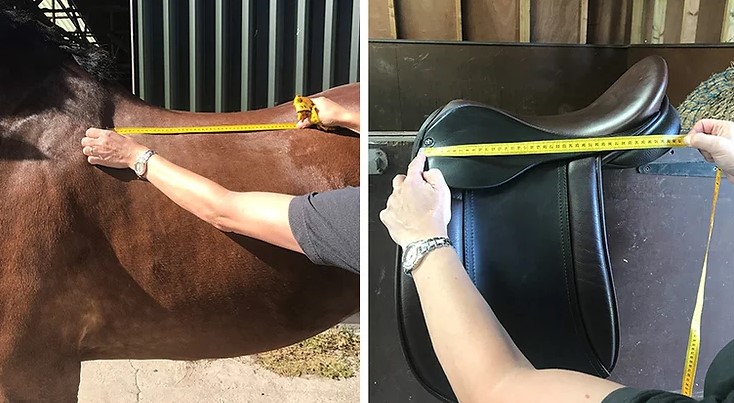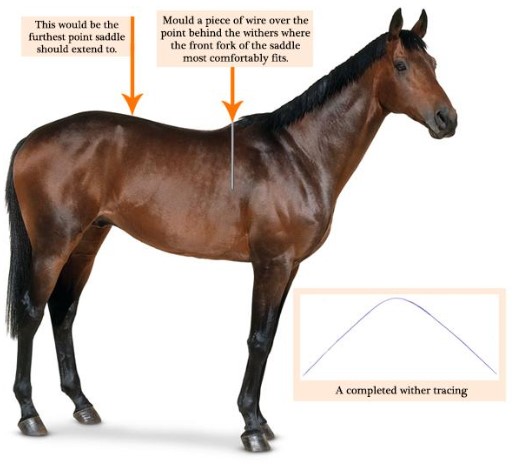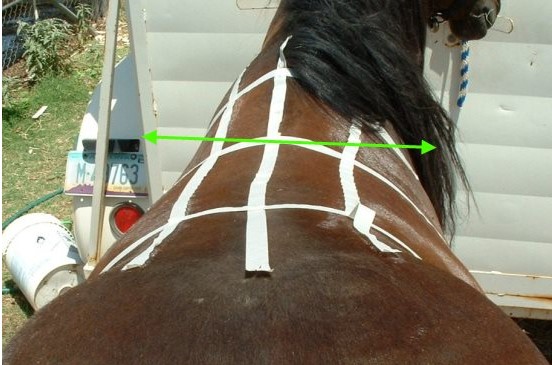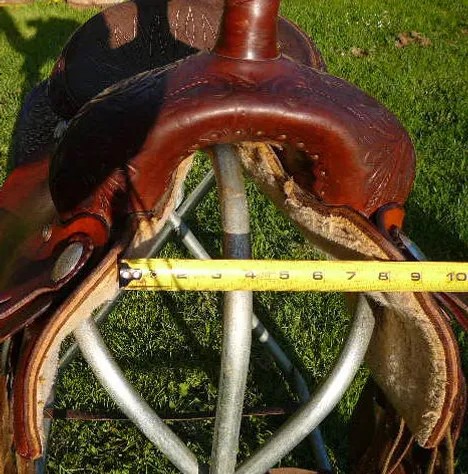Saddles play a crucial role in horse riding, providing support and stability for both horse and rider. A properly fitted saddle is essential for the comfort and well-being of the horse, as well as the effectiveness of the rider.
Measuring a horse for a saddle is necessary to ensure that the saddle fits correctly, preventing discomfort, pain, and potential injury to the horse. It also contributes to the rider’s stability and balance, enhancing their performance and enjoyment of riding.
This guide will outline the importance of saddle fit, provide instructions for taking basic measurements and using a wither template (optional), and discuss additional factors to consider. Remember, these measurements are for informational purposes only and should not replace a professional fitting.
Why Is It Important to Make Sure Your Saddle Fits Properly?
Ensuring that your saddle fits properly is crucial for the comfort, well-being, and performance of both horse and rider. A well-fitting saddle prevents discomfort, pain, and potential injury for the horse by avoiding pressure points and allowing for unrestricted movement.
It also promotes rider stability and balance, facilitating clear communication with the horse and enhancing overall performance. By prioritizing proper saddle fit, riders can prevent long-term issues, maintain a positive partnership with their horse, and enjoy a safer and more enjoyable riding experience.
Understanding Saddle Fit
A well-fitting saddle is essential for the horse’s comfort and well-being. Poor saddle fit can lead to a range of issues, from discomfort and pain to more serious problems such as muscle atrophy and back injuries. It’s not just the horse that suffers; an ill-fitting saddle can also affect the rider’s balance and position, hindering their performance and potentially causing discomfort or injury.
Different disciplines require different saddle fits, with considerations such as the horse’s conformation, movement, and the rider’s position all playing a role. For example, a dressage saddle is designed to allow the horse freedom of movement through the back and shoulders, while providing the rider with a deep seat for stability and communication. In contrast, a jumping saddle is built with shorter, more forward-cut flaps to accommodate the rider’s position over fences.
Tools Needed for Measuring
Before diving into the measurement process, it’s essential to gather the necessary tools. These may include a measuring tape, a withers gauge, and possibly a flexicurve for assessing the horse’s back shape. Each tool serves a specific purpose in accurately measuring the horse for a saddle.
A measuring tape is used to determine the horse’s back length, which is crucial for selecting the correct seat size. The withers gauge helps measure the width of the horse’s withers, ensuring that the saddle’s tree width matches the horse’s conformation. Finally, a flexicurve can be used to assess the curvature of the horse’s back, ensuring that the saddle’s panels will make even contact along the length of the spine.
Step-by-Step Guide to Measuring a Horse for a Saddle
Now let’s walk through the process of measuring a horse for a saddle step by step:
Measuring the Horse’s Back Length
Start by standing the horse squarely on level ground. Using a measuring tape, measure from the back edge of the shoulder blade to the point of the buttock. This measurement will give you an indication of the seat size needed for the saddle.

Image source: ahsaddles
Determining the Wither Width
Next, use a withers gauge to measure the width of the horse’s withers. Place the gauge over the highest point of the withers and adjust it until it fits snugly against the horse’s sides. Note the measurement, as this will help determine the appropriate tree width for the saddle.

Image source: jamessaddlery
Assessing the Horse’s Back Shape
Use a flexicurve or a flexible ruler to assess the curvature of the horse’s back. Gently curve the flexicurve along the length of the horse’s spine, taking care to follow the natural contours of the back. This will help ensure that the saddle’s panels will conform to the horse’s back shape, providing optimal weight distribution and comfort.

Image source: rodnikkel
Measuring the Gullet Width
The gullet width is the distance between the panels of the saddle at the front. To measure this, place a straight edge (such as a ruler or stiff piece of cardboard) across the horse’s withers, parallel to the ground. Measure the distance between the edges of the panels where they sit on either side of the withers. This measurement will help ensure that the saddle’s tree width is suitable for the horse’s conformation.

Image source: therightfitequine
Examining the Saddle Position and Balance
Finally, it’s essential to assess the saddle’s position and balance on the horse’s back. Place the saddle on the horse without a pad, ensuring that it sits evenly from front to back and side to side. Check that there is adequate clearance over the withers and along the spine, and that the saddle is not sitting too far forward or too far back. Once the saddle is in position, carefully observe the horse’s movement at the walk, trot, and canter to ensure that it allows for freedom of movement and does not cause any discomfort or restriction.
Common Mistakes to Avoid
While measuring a horse for a saddle may seem straightforward, there are several common mistakes that riders and horse owners often make:
Misinterpreting Measurements
It’s essential to take accurate measurements and interpret them correctly to ensure a proper saddle fit. Even small discrepancies in measurement can lead to an ill-fitting saddle, causing discomfort or even injury to the horse.
Failing to Account for the Horse’s Individual Conformation
Every horse is unique, with its own conformation and movement patterns. It’s crucial to take these factors into account when measuring for a saddle, rather than relying solely on standard measurements or templates.
Overlooking the Importance of Saddle Fit for Rider Comfort and Performance
While much emphasis is placed on saddle fit for the horse, it’s equally important to consider the rider’s comfort and position. An ill-fitting saddle can affect the rider’s balance and position, hindering their performance and potentially causing discomfort or injury over time.
Seeking Professional Assistance
If you’re unsure about how to measure your horse for a saddle or if you’re struggling to find a saddle that fits correctly, don’t hesitate to seek professional assistance. A qualified saddle fitter can assess your horse’s conformation and movement patterns, as well as your own riding position and preferences, to recommend a saddle that provides optimal fit and comfort for both horse and rider.
Explanation of When to Consult a Professional Saddle Fitter
It’s a good idea to consult a professional saddle fitter whenever you’re purchasing a new saddle, especially if you’re unsure about the fit or if your horse has any special fitting considerations. A saddle fitter can assess your horse’s conformation and movement, as well as your own riding position and preferences, to recommend a saddle that provides optimal fit and comfort.
Benefits of Working with a Qualified Saddle Fitter
Working with a qualified saddle fitter offers several benefits, including:
- Expertise: Saddle fitters undergo specialized training and certification to assess saddle fit accurately.
- Customization: A saddle fitter can recommend customizations or adjustments to ensure a perfect fit for both horse and rider.
- Follow-up: Many saddle fitters offer follow-up services to ensure that the saddle continues to fit correctly as the horse’s shape changes over time.
How to Find a Reputable Saddle Fitter in the UK
When seeking out a saddle fitter, it’s essential to do your research and choose a reputable professional with a track record of success. Ask for recommendations from fellow riders or your equestrian network, and look for fitters who are certified by reputable organizations such as the Society of Master Saddlers (SMS) or the British Equestrian Trade Association (BETA).
Conclusion
Ensuring your horse has a properly fitting saddle is essential for their comfort, well-being, and performance. While taking measurements can provide a starting point, a professional saddle fitting is vital for ensuring the perfect fit for your horse.
A qualified saddle fitter will assess your horse’s conformation, riding style, and discipline to recommend a saddle that offers optimal comfort, balance, and freedom of movement.
Frequently Asked Questions (FAQs)
To measure a saddle’s width, place a flexible measuring tape or ruler across the widest part of the saddle’s seat. Ensure the tape is level and straight, and measure from the inside of one side of the seat to the inside of the other. This measurement will give you the saddle’s width, helping you determine if it will fit your horse comfortably.
Measuring your pony for a saddle involves several steps. Start by determining the length of your pony’s back from the shoulder blade to the point of the buttock using a measuring tape. Then, measure the width of the withers using a withers gauge. Additionally, assess the curvature of your pony’s back using a flexicurve or flexible ruler. Finally, ensure the saddle’s position and balance on your pony’s back, observing their movement for comfort and freedom.
To measure your horse’s withers for saddle fit, place a withers gauge over the highest point of the withers and adjust it until it fits snugly against the horse’s sides. Note the measurement, which will help determine the appropriate tree width for the saddle. Ensuring the saddle’s tree width matches your horse’s withers width is crucial for a comfortable fit and to prevent pressure points or rubbing.
Fitting a saddle correctly involves several steps to ensure comfort and performance for both horse and rider. Start by measuring your horse’s back length, withers width, and assessing their back shape. Then, select a saddle with an appropriate seat size and tree width that matches your horse’s conformation. Place the saddle on your horse’s back without a pad, ensuring it sits evenly and doesn’t pinch or rub. Check the saddle’s position and balance, observing your horse’s movement for signs of discomfort or restriction. Adjust as needed to achieve a proper fit, ensuring clearance over the withers and along the spine. Finally, ride in the saddle to confirm comfort and stability, making any further adjustments if necessary.
